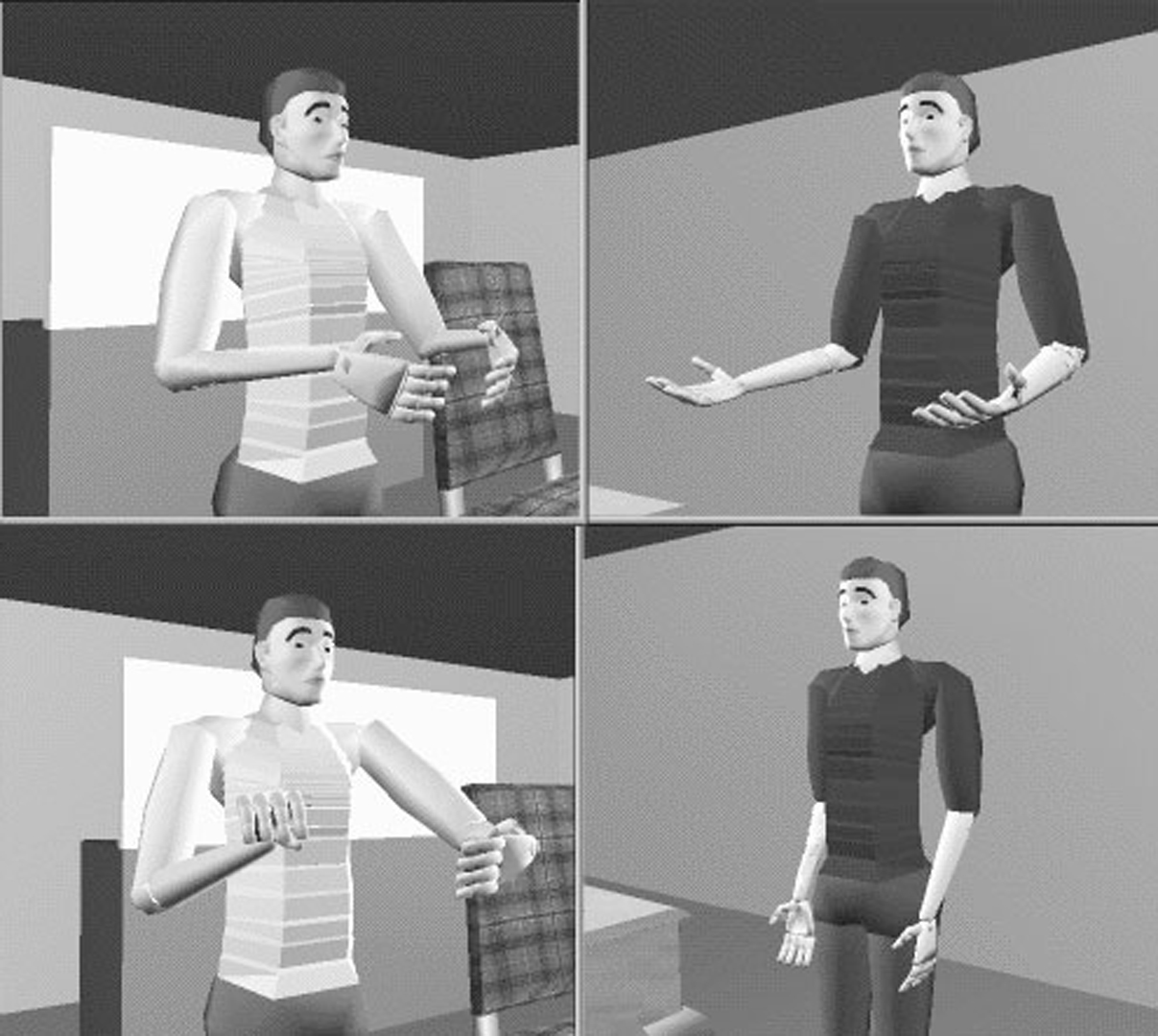“Animated conversation: rule-based generation of facial expression, gesture & spoken intonation for multiple conversational agents” by Cassell, Pelachaud, Badler, Steedman, Achorn, et al. …
Conference:
Type(s):
Title:
- Animated conversation: rule-based generation of facial expression, gesture & spoken intonation for multiple conversational agents
Presenter(s)/Author(s):
Abstract:
We describe an implemented system which automatically generates and animates conversations between multiple human-like agents with appropriate and synchronized speech, intonation, facial expressions, and hand gestures. Conversation is created by a dialogue planner that produces the text as well as the intonation of the utterances. The speaker/listener relationship, the text, and the intonation in turn drive facial expressions, lip motions, eye gaze, head motion, and arm gestures generators. Coordinated arm, wrist, and hand motions are invoked to create semantically meaningful gestures. Throughout we will use examples from an actual synthesized, fully animated conversation.
References:
1. M. Argyle and M. Cook. Gaze and Mutual gaze. Cambridge University Press, 1976.
2. N. I. Badler, B. A. Barsky, and D. Zeltzer, editors. Making ThemMove: Mechanics, Control, and Animation of Articulated Figures. Morgan-Kaufmann, San Mateo, CA, 1991.
3. N. I. Badler, C. Phillips and B. L. Webber. Simulating Humans: Computer Graphics, Animation, and Control. Oxford University Press, June 1993.
4. Welton M. Becket. The jack lisp api. Technical Report MS-CIS-94-01/Graphics Lab 59, University of Pennsylvania, 1994.
5. Tom Calvert. Composition of realistic animation sequences for multiple human figures. In Norman I. Badler, Brian A. Barsky, and David Zeltzer, editors, Making Them Move: Mechanics, Control, and Animation of Articulated Figures, pages 35-50. Morgan-Kaufmann, San Mateo, CA, 1991.
6. J. Cappella. personal communication, 1993.
7. Justine Cassell, Mark Steedman, Norm Badler, Catherine Pelachaud, Matthew Stone, Brett Douville, Scott Prevost and Brett Achorn. Modeling the interaction between speech and gesture. Proceedings of the Cognitive Science Society Annual Conference, 1994.
8. Justine Cassell and David McNeill. Gesture and the poetics of prose. Poetics Today, 12:375-404, 1992.
9. Justine Cassell, David McNeill, and Karl-Erik McCullough. Kids, don’t try this at home: Experimental mismatches of speech and gesture. presented at the International Communication Association annual meeting, 1993.
10. D. T. Chen, S. D. Pieper, S. K. Singh, J. M. Rosen, and D. Zeltzer. The virtual sailor: An implementation of interactive human body modeling. In Proc. 1993 Virtual Reality Annual International Symposium, Seattle, WA, September 1993. IEEE.
11. M.M. Cohen and D.W. Massaro. Modeling coarticulation in synthetic visual speech. In N.M. Thalmann and D.Thalmann, editors, Models and Techniques in Computer Animation, pages 139-156. Springer-Verlag, 1993.
12. G. Collier. Emotional expression. Lawrence Erlbaum Associates, 1985.
13. W.S. Condon and W.D. Osgton.Speech and body motion synchrony of the speaker-hearer. In D.H. Hortonand J.J. Jenkins, editors, The perceptionof Language, pages 150-184. Academic Press, 1971.
14. S. Duncan. Some signals and rules for taking speaking turns in conversations. In Weitz, editor, Nonverbal Communication. Oxford University Press, 1974.
15. P. Ekman. Movements with precise meanings. The Journal of Communication, 26, 1976.
16. P. Ekman. About brows: emotional and conversational signals. In M. von Cranach, K. Foppa, W. Lepenies, and D. Ploog, editors, Humanethology: claims and limits of a new disipline: contributions to the Colloquium, pages 169-248. Cambridge University Press, Cambridge, England; New-York, 1979.
17. P. Ekmanand W. Friesen. Facial Action Coding System. Consulting Psychologists Press, Inc., 1978.
18. Jean-Paul Gourret, Nadia Magnenat-Thalmann, and Daniel Thalmann. Simulation of object and human skin deformations in a grasping task. Computer Graphics, 23(3):21-30, 1989.
19. P. Kalra, A. Mangili, N. Magnenat-Thalmann, and D. Thalmann. Smile: A multilayeredfacial animationsystem. In T.L. Kunii, editor, Modeling in Computer Graphics. Springer-Verlag, 1991.
20. A. Kendon. Movement coordination in social interaction: some examples de-scribed. In Weitz, editor, Nonverbal Communication. Oxford University Press, 1974.
21. AdamKendon. Gesticulation and speech: Two aspects of the process of utterance. In M.R.Key, editor, The Relation between Verbal and Nonverbal Communication, pages 207-227. Mouton, 1980.
22. Jintae Lee and Tosiyasu L. Kunii. Visual translation: From native language to sign language. In Workshop on Visual Languages, Seattle, WA, 1993. IEEE.
23. Philip Lee, Susanna Wei, Jianmin Zhao, and Norman I. Badler. Strength guided motion. Computer Graphics, 24(4):253-262, 1990.
24. Mark Liberman and A. L. Buchsbaum. Structure and usage of current Bell Labs text to speech programs. Technical MemorandumTM 11225-850731-11, AT&T Bell Laboratories, 1985.
25. Jeffrey Loomis, Howard Poizner, Ursula Bellugi, Alynn Blakemore, and John Hollerbach. Computer graphic modeling of American Sign Language. Computer Graphics, 17(3):105-114, July 1983.
26. Nadia Magnenat-Thalmann and Daniel Thalmann. Human body deformations using joint-dependent local operators and finite-element theory. In Norman I. Badler, Brian A. Barsky, and David Zeltzer, editors, Making Them Move: Me-chanics, Control, and Animation of Articulated Figures, pages 243-262.Morgan-Kaufmann, San Mateo, CA, 1991.
27. David McNeill. Handand Mind: What Gestures Reveal about Thought. University of Chicago, 1992.
28. M. Patel. Making FACES. PhD thesis, School of Mathematical Sciences, Univer-sity of Bath, Bath, AVON, UK, 1991.
29. C. Pelachaud, N.I. Badler, and M. Steedman. Linguistic issues in facial animation. In N. Magnenat-Thalmann and D. Thalmann, editors, Computer Animation ’91, pages 15-30. Springer-Verlag, 1991.
30. Richard Power. The organisation of purposeful dialogues. Linguistics, 1977.
31. Scott Prevost and Mark Steedman. Generating contextually appropriate intonation. In Proceedings of the 6th Conference of the European Chapter of the Association for Computational Linguistics, pages 332-340, Utrecht, 1993.
32. Ellen F. Prince. The ZPG letter: Subjects, definiteness and information status. In S. Thompson and W. Mann, editors, Discourse description: diverse analyses of a fund raising text, pages 295-325. John Benjamins B.V., 1992.
33. Hans Rijpkema and Michael Girard. Computer animation of hands and grasping. Computer Graphics, 25(4):339-348, July 1991.
34. Barbara Robertson. Easy motion. Computer Graphics World, 16(12):33-38, December 1993.
35. Klaus R. Scherer. The functions of nonverbal signs in conversation. In H. Giles R. St. Clair, editor, The Social and Physhological Contexts of Language, pages 225-243. Lawrence Erlbaum Associates, 1980.
36. Mark Steedman. Structure and intonation. Language, 67:260-296, 1991.
37. Akikazu Takeuchi and Katashi Nagao. Communicative facial displays as a new conversational modality. In ACM/IFIP INTERCHI’93, Amsterdam, 1993.
38. K. Tuite. The production of gesture. Semiotica, 93(1/2), 1993.




